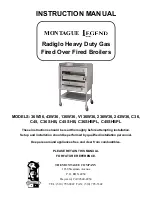
September
2012 Page
26
1) FILL, ISOLATE, AND PRESSURE TEST
Although the solid fuel boiler is factory pressure tested, it should
be tested in the fi eld to ensure that no damage has occurred
during shipping. Isolate the solid fuel boiler from the system
prior to pressure testing.
A) Shut off isolation valves “B” and “C”.
B) Shut drain valve “G”.
C) Open drain valves “D” and “E”.
D) Keep fi ll valve or attach hose to drain valve “G”. (either side is
acceptable).
Connect the other end of the hose to a water source with
pressure between 30 and 40 psi.
E) Slowly open drain valve “G” to fi ll the boiler.
F) When water fl ows freely from both drain valves “D” and
“E”. Shut drain valves “G”, “D” and “E”.
G) Slowly open drain valve “D” and closely watch the
pressure
gauge.
H) Shut drain valve “G” when test pressure on pressure gauge
reaches no more than 29 psi. The pressure relief valve will
discharge if pressure exceeds 30 psi.
The person pressurizing the appliance must
either be able to see the pressure gauge or must
be in direct communications with someone who
can see the pressure gauge. DO NOT EXCEED 45
PSI. Failure can result in severe personal injury,
death, or substantial property damage.
I) Test for no longer than 10 minutes at 29 psi. Ensure constant
gauge pressure has been maintained throughout test.
Check for leaks, Repair if necessary.
Leaks must be repaired at once. Failure to do
so can damage boiler, resulting in substantial
property damage. Do not leave Appliance
unattended. A cold water fi ll could expand as it
heats up and cause excessive pressure, resulting in
severe personal injury, death or substantial
property
damage.
J) Disconnect hose from water source and slowly open drain valve
“H” to lower boiler pressure to 15 psi.
The Relief Valve must be Installed in the system
prior to operation. Failure can result in severe
personal injury, death, or substantial property
damage.
INITIAL SYSTEM FILL
DANGER
WARNING
DANGER
DANGER
















































